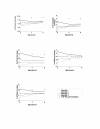The quality of girls' diets declines and tracks across middle childhood
- PMID: 15169562
- PMCID: PMC416567
- DOI: 10.1186/1479-5868-1-5
The quality of girls' diets declines and tracks across middle childhood
Abstract
BACKGROUND: Food group intakes by US children are below recommendations and micronutrient inadequacies have been reported. There are few longitudinal data that focus on developmental changes in food and nutrient intake from early to middle childhood. We examined changes in nutrient and food group intakes over time and the tracking of intakes across middle childhood in a longitudinal sample of girls. METHODS: Three multiple-pass 24-hour diet recalls were conducted in a sample of 181 non-Hispanic White girls at ages 5, 7, and 9 years. Food and nutrient data were averaged across 3 days. Analyses of time effects were conducted using repeated measures analysis of variance and tracking of intakes was assessed via rank analysis. RESULTS: We found significant decreases in nutrient densities (intakes per 1000 kcal) of vitamins C and D, calcium, phosphorus, magnesium and zinc at age 9. Girls maintained their relative quartile positions for these micronutrients from ages 5-9. Analysis of food group data showed similar trends. At age 9, significantly fewer girls were meeting the recommendations for dairy, fruit and vegetable servings than at age 5 and girls also tended to remain in their respective quartiles over time, especially for fruit and dairy intakes. CONCLUSIONS: These results highlight the importance of developing healthy eating practices during early childhood when caretakers have considerable control over children's food intake.
Figures
References
-
- National Academy of Sciences. National Research Council . Diet & Health: Implications for Reducing Chronic Disease Risk. National Academy Press; 1989. - PubMed
-
- US Public Health Service . The Surgeon General's Report on Nutrition and Health. Washington, DC, Office of the Surgeon General; 1988.
-
- Berenson G, Wattigney WA, Bao W, Nicklas TA, Jiang X, Rush JA. Epidemiology of early primary hypertension and implications for prevention: The Bogalusa Heart Study. Journal of Human Hypertension. 1994;8:303–311. - PubMed
-
- Deckelbaum RJ, Williams CL. Childhood Obesity: The Health Issue. Obesity Research. 2001;9:239S–243S. - PubMed
Grants and funding
LinkOut - more resources
Full Text Sources



